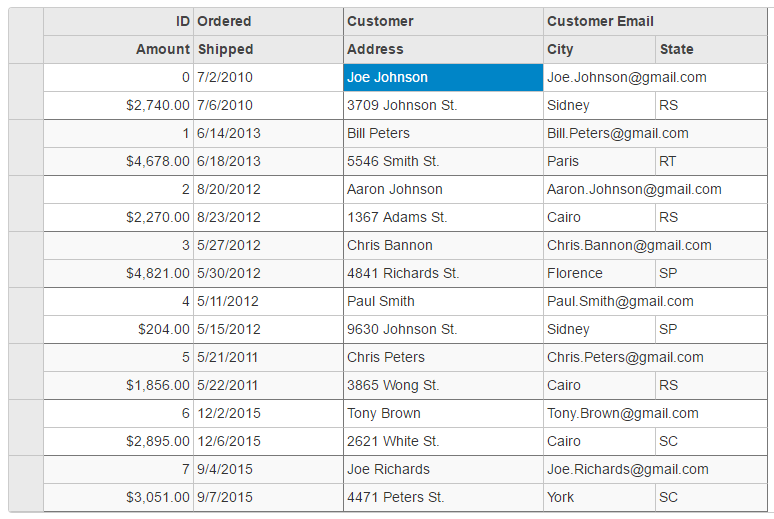This topic describes how to add a MultiRow control to your MVC application and populate data in it. The below example demonstrates how to achieve local model binding in MultiRow control. You can also perform remote data binding in MultiRow control, for more information, see Remote Data Binding.
To accomplish this, follow these steps:

Orders.cs). For more information on how to add a new model, see Adding Controls.Orders.cs model. We are using Orders class to represent sales order data in the database. Each instance of Orders object will correspond to a record in MultiRow control.| Orders.cs |
Copy Code
|
|---|---|
using System; using System.Collections.Generic; using System.Linq; using System.Web; namespace MultiRow.Models { public class Orders { private static object _lockObj = new object(); private static Random Rand = new Random(); private static IList<Order> _orders; private static IList<string> _cities; private static IList<Customer> _customers; public class Customer { public int Id { get; set; } public string Name { get; set; } public string Address { get; set; } public string City { get; set; } public string State { get; set; } public string Email { get; set; } } public class Order { public int Id { get; set; } public DateTime Date { get; set; } public DateTime ShippedDate { get; set; } public double Amount { get; set; } public Customer Customer { get; set; } } public static IList<Order> GetOrders() { if (_orders == null) { var today = DateTime.Now.Date; var customers = GetCustomers(); _orders = new List<Order>(); for (int i = 0; i < 8; i++) { var shipped = today.AddDays(-Rand.Next(-1, 3000)); var order = new Order { Id = i, Date = shipped.AddDays(-Rand.Next(1, 5)), ShippedDate = shipped, Amount = Rand.Next(10000, 500000) / 100, Customer = customers[Rand.Next(0, customers.Count - 1)], }; _orders.Add(order); } } return _orders; } public static IList<Customer> GetCustomers() { if (_customers == null) { var firstNames = new[] { "Aaron", "Paul", "John", "Mark", "Sue", "Tom", "Bill", "Joe", "Tony", "Brad", "Frank", "Chris", "Pat" }; var lastNames = new[] { "Smith", "Johnson", "Richards", "Bannon", "Wong", "Peters", "White", "Brown", "Adams", "Jennings" }; var cities = GetCities(); var states = new[] { "SP", "RS", "RN", "SC", "CS", "RT", "BC" }; _customers = new List<Customer>(); for (int i = 0; i < 50; i++) { var first = firstNames[Rand.Next(0, firstNames.Length - 1)]; var last = lastNames[Rand.Next(0, lastNames.Length - 1)]; var customer = new Customer { Id = i, Name = first + " " + last, Address = Rand.Next(100, 10000) + " " + lastNames[Rand.Next(0, lastNames.Length - 1)] + " St.", City = cities[Rand.Next(0, cities.Count - 1)], State = states[Rand.Next(0, states.Length - 1)], Email = first + "." + last + "@gmail.com", }; _customers.Add(customer); } } return _customers; } public static IList<string> GetCities() { { if (_cities == null) { _cities = new[] { "York", "Paris", "Rome", "Cairo", "Florence", "Sidney", "Hamburg", "Vancouver" }; } } return _cities; } } } |
|
To add a MultiRow control to the application, follow these steps:
Add a new Controller
MultiRowController).| C# |
Copy Code
|
|---|---|
using MultiRow.Models; using System; using System.Collections.Generic; using System.Linq; using System.Web; using System.Web.Mvc; |
|
| MultiRowController.cs |
Copy Code
|
|---|---|
public ActionResult Index() { var model = Orders.GetOrders(); return View(model); } |
|
Add a View for the Controller
In the view, we create an instance of MultiRow control and bind it to a data source using .Bind property. The layout definition property helps us to define the column and row layout of the control.
MultiRowController.Index().| Index.cshtml |
Copy Code
|
|---|---|
@using MultiRow.Models
@model IEnumerable<Orders.Order>
<br />
@(Html.C1().MultiRow<Orders.Order>()
.Bind(bl => bl.Bind(Model))
.LayoutDefinition(ld =>
{
ld.Add().Header("Order").Colspan(2).Cells(cells =>
{
cells.Add(cell => cell.Binding("Id").Header("ID").CssClass("id").Width("150"))
.Add(cell => cell.Binding("Date").Header("Ordered").Width("150"))
.Add(cell => cell.Binding("Amount").Header("Amount").Format("c").CssClass("amount"))
.Add(cell => cell.Binding("ShippedDate").Header("Shipped"));
});
ld.Add().Header("Customer").Colspan(3).Cells(cells =>
{
cells.Add(cell => cell.Binding("Customer.Name").Name("CustomerName").Header("Customer").Width("200"))
.Add(cell => cell.Binding("Customer.Email").Name("CustomerEmail").Header("Customer Email").Colspan(2))
.Add(cell => cell.Binding("Customer.Address").Name("CustomerAddress").Header("Address"))
.Add(cell => cell.Binding("Customer.City").Name("CustomerCity").Header("City"))
.Add(cell => cell.Binding("Customer.State").Name("CustomerState").Header("State"));
});
}))
|
|